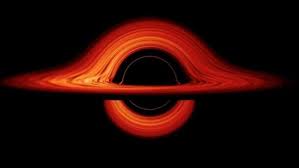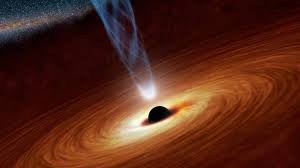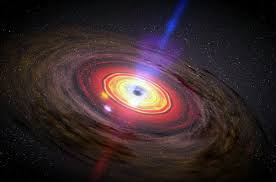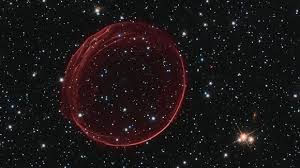THE INFORMATION PARADOX IN AN: TOWARDS A FUNDAMENTAL DESCRIPTION OF SPACE-TIME (II)
- planck
- Aug 12
- 8 min read
In the previous article, we saw how entanglement entropy (EE) measures the number of entangled microstates (qubits) between two systems. We also saw how, if information is conserved, a BNA must obey the so-called Page curve. In this article, we will explore the fascinating phenomena that imply a possible resolution of the information paradox. But before continuing and studying in more detail how information manages to escape from the BNA, we need to understand two important concepts: the AdS/CFT duality and the so-called Ryu-Takayanagi (RTS) surfaces.
AdS/CFT Duality and Holography
The interior of a NA can be roughly considered an AdS (Anti-De-Sitter) spacetime. AdS spacetime has negative curvature, and any object located within it will be immersed in a gravitational potential.

Figure 1
We can schematically represent the AdS space-time as a cylinder where the horizontal axis is space and the vertical axis represents time:

Figure 2
The AdS/CFT duality states that all information about the geometry of AdS spacetime (the part inside the "Boundary" circle) is stored in a CFT that resides at the edge of AdS spacetime ("Boundary" circle).
The famous AdS/CFT duality tells us that an AdS spacetime in n dimensions is equivalent to a CFT (a quantum system) in n-1 dimensions residing on its asymptotic "edge." This means that all information regarding the geometry and degrees of freedom inside the NA is stored in the CFT, which resides on the "edge" of the NA. This is similar to how information is stored in a hologram, hence the term "holography."
Interlacing bridges and the Ryu-Takayanaka surface
Let's make a cut to obtain a "slice" of the AdS space-time at a given instant ("Border" circle in Figure 2):

Figure 3
Next we take any two points on the edge, for example points A and B:

Figure 4
The shortest path between A and B in AdS space is a geodesic. If we draw the geodesic between A and B (red line in Figure 5), we find that AdS space is divided into two surfaces, which we'll call AdS1 and AdS2:

Figure 5
The AdS2 surface is the Ryu-Takayanagi surface of the boundary region between A and B. The so-called Ryu-Takayanagi formula establishes a link between entropy and geometry: the entanglement entropy of the boundary between points A and B is proportional to the minimum surface area, at a given time in AdS space, whose boundary is the region between A and B, i.e., the AdS2 region. The AdS1 and AdS2 spaces are complementary , and the EE of both surfaces is the same. The AdS/CFT duality implies that the boundary contains all the information about the interior. If we consider only the boundary region between A and B, then we do not have all the information about the interior; we only have the information about the AdS1 region. However, an observer located in the AdS1 region can calculate the EE of the AdS2 region even if they do not have access to it. In this way, the AdS2 region would be similar to a NA, and the red line would behave like the holographic boundary where the information about the interior of the NA is encoded. All this tells us that the RTS boundary (red line) behaves like a holographic edge separating disconnected surfaces.
An important detail must be noted: if we had not split the edge between points A and B, that is, if points A and B spanned the entire edge, then the RTS would be zero : there would be no Ryu-Takaganagi surface.
For simplicity, we have restricted ourselves to two-dimensional AdS spaces. In three spatial dimensions, the image of a Ryu-Takayanagi surface would be:

Figure 6
The RT formula is classical and applies to static spacetimes. For real spacetimes with dynamic (semiclassical) quantum effects, the so-called "Quantum Entanglement Surface" (QES) is used; however, the fundamental idea behind it is the same as the one we described in this section.
Finally, the concept of entanglement bridge (EB) remains to be defined. The EB is simply the causal zone of a portion of the edge, that is, the AdS zone that can be causally affected by a portion of the edge:

Figure 7
The W[R] area is the entanglement bridge of the edge part R. All information stored in R can only causally affect the volume of the interior contained between the two W[R] bridges (the light cones are represented forming a 45º inclination)
The AN before Page's time
Now we can begin to study the astonishing phenomena linked to the information paradox. As we shall see, the process can be summarized in two key points.
A spacetime with an evaporating BF can be considered as a system composed of two distinct regions: the interior part encoded in the CFT of the BF, CFTan , and the exterior part where the Hawking radiation encoded in the CFTad is "stored." As we shall see, one of the key factors lies in the transfer of information from the CFTan to the CFTad.
When not much time has passed since the AN started radiating, that is, before the Page time, the AN can be described by the following Penrose diagram:

Figure 8
The dashed line is the horizon of the NA, and the red sawtooth line is the NA singularity. The pink line represents the position of an observer located at the boundary of the AdS space of the NA (acting as the holographic boundary of the NA). This position varies in time: the lower point of this line is the initial time when the NA has not yet formed, and the upper point is the final time when the NA has already evaporated and the singularity no longer exists. The green area represents the entanglement bridge of the CFTan at time t, and the blue area the entanglement bridge of the CFTrad.
The first key to the whole process is the following: at the instant t before the Page time the boundary of the AN contains the information of the entire interior of the AN since the spatial "slice" at time t (yellow line) is inside the EW of the CFTan (green light cone), therefore, all the information about the AN is still inside it (encoded in the CFT of its asymptotic boundary). The yellow line represents the "slice" (Cauchy surface) of AdS space of the AN at time t, therefore points A and B are equivalent to those in figure 4, only that in this case the line covers the entire interior, and therefore, no Ryu-Takayanagi surface exists.
This stage corresponds to phase 1 of the Page curve:

Figure 9
In phase 1 the minimal surface (the RTS) is zero since the total entropy is dominated by the thermodynamic entropy of the interior of the AN and outside the AN a surface (Cauchy surface) of zero entropy can be found.
The AN after Page's time
During Page's time, something truly extraordinary happens:

Figure 10
At an instant t greater than the Page time, the edge no longer has information about the entire interior of the NA, but only about the area of the green light cone (the EW of the CFTan). Now, points A and B do not cover the entire interior of the NA (yellow line), and therefore, at Page time, a new entanglement bridge appears within the NA. This "new area" located inside the NA is called an island and is limited by a "quantum entanglement surface": the QES point. The situation is analogous to that seen in Figure 5: the green area would correspond to the AdS1 area, and the island would be the AdS2 area, which is not accessible from the outside.
The second key to the process is this: the information of the Island region is no longer encoded in the CFTan (it is no longer in the CFTan's EW) but in the CFTrad , and therefore, for the purposes of entanglement entropy, it is no longer part of the interior of the NA. Because of this, its EE no longer contributes to the total EE between the interior and exterior, which causes the total EE to begin to decrease as the Island increases in size. This explains the second part of the Page curve:

Figure 11
The RTS is defined as the Cauchy surface of lowest entropy. In phase 2, the entropy inside the NA begins to be lower than that outside, so the RTS is no longer zero and will be located inside the NA. Therefore, an RTS appears inside the NA, causing part of the interior entropy not to count as EE. This causes the total EE to decrease, and the curve to follow the black line instead of the green line in Hawking's original calculation.
This means that, starting at the Page time, information begins to escape from the NA. In holographic terms, the information from the NA CFT has been transferred to the Hawking radiation CFT. This information transfer in the CFTs involves a reorganization of the microstates on the AdS side: a portion of the spacetime that formed the interior of the NA is now part of the exterior spacetime.
As the island (whose information is encoded in the CFTrad) increases in size and the size of the AN decreases, all the information becomes encoded in the CFTrad (blue area) and therefore, at the end of the process, all the information is outside the black hole:

Figure 12
This "transfer" of information therefore implies that information escapes from the NA. This process can also be represented by the so-called ER=EPR equality: every pair of entangled systems are connected by a kind of quantum wormhole. The process we have described can be independently formulated in terms of ER=EPR through what is known as "replica trick," which takes into account a superposition of all possible geometries and topologies. Very encouragingly, this formulation yields results equivalent to those presented in this article, also allowing the Page curve to be resolved.
It should be noted that while all of this work represents a major step forward toward definitively resolving the information paradox, several key issues remain to be resolved:
1st) Can real ANs formed by stellar collapse be satisfactorily explained by holographic methods?
2) What is the specific physical mechanism that allows the transfer of information from the inside to the outside? What are its "fundamental components"?
3rd) Can we be sure that quantum gravity-based effects do not influence the process?
4) What physical process can we use to recover the enormously "tangled" information hidden in Hawking radiation?
Speculations on the nature of space-time
We will conclude this article with a series of (very speculative and personal) questions about the ultimate nature of space-time:
- Is the geometry of space-time that we see in our Universe a sum of all possible geometries-topologies?
- The "replica-trick" approach suggests a topological transition of spacetime in Page time from a superposition of geometries dominated by black holes to one dominated by wormholes. Can this topological transition be explained in terms of any of our theories that aim to explain quantum gravity (string theory)?
- Does information escape from the AN thanks to the existence of quantum wormholes?
- What is the nature of the non-local effects involved?
- Is the Universe at its fundamental level non-geometric and non-local? How does the geometry of spacetime emerge from the fundamental degrees of freedom?
And the final question: Will fundamental physics be able to determine the ultimate nature of the space-time of our Universe?
Sources: The most famous paradox in Physics nears its end ,Introduction to Entanglement Entropy , Entanglement wedge reconstruction and the information paradox , Towards a resolution of black holes information loss problem








Comments